| Intermediate Technology Education | Energy and Power Technology | Pre-Design | Topic 3 | Activity 7 |
Forms of Kinetic Energy
- Give examples of kinetic energy
- Investigate the applications of kinetic and potential energy in technological problems and solutions
Forms of Kinetic Energy
Forms of kinetic energy include
- Radiant energy
- Thermal energy
- Motion energy (mechanical)
Radiant Energy
Radiant energy is electromagnetic energy. It includes visible light, infrared light, and radio waves. All its energy we use, regardless of the source, started as radiant energy from the sun, Radiant energy from the sun is is harvested in two main ways
- By using photovoltaic materials to convert the radiant energy directly into electricity.
- By utilizing the thermal energy generated when the radiant energy is absorbed by something. Radiant energy is converted to thermal energy. The thermal energy applications of radiant energy are covered in the next section
Radiant Energy to Electrical Energy using Photovoltaic Devices
One of the ways that scientists describe light energy is that it takes the form of photons. Photons are described as discrete packets of energy embedded in light. When light strikes an object, the photons of energy are absorbed by the object. The energy added to the electrons' existing energy causes more rapid action of the electrons, atoms and molecules, and object gets hotter. Photovoltaic devices are able to convert this increased electron energy directly into electricity.
The basic structure of a photovoltaic device is shown in the next figure. It consists of a sandwich of three layers of material
- p-type material for the top layer. This is silicon crystals with an added material that has too few electrons in its atoms. This layer is transparent. Radiant energy from the sun passes through it.
- Junction. The junction is where the p-type and n-type material make contact. An an electric field is formed by the contact atoms between the n-type and p-type materials. Its effect is to allow electrons to flow in only one direction, from the p-type to the n-type
- n-type material for the bottom layer. This is silicon crystals with added material that has an excess of electrons. This layer absorbs energy from sunlight. The absorbed energy causes electrons to move from the n-type layer to the p-type layer.
For electricity to be created, the p-type and n-type materials have to be connected to an external circuit. This provides a path for the electrons to follow. The figure show two devices connected, a light and a motor. Either of them gives the electrons a path.
Instead of a motor or light, you could put any device into the circuit as a load. A battery charger is a typical application.
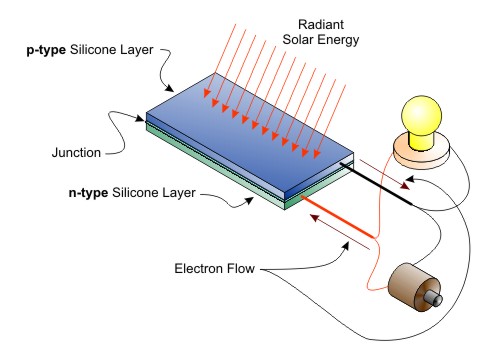
Figure A Photovoltaic Cell converts Radiant Energy directly into Electricity
Photovoltaic power has a number of advantages
- It is noiseless and pollution free
- It is renewable
- It reduces reliance on fossil fuels
Photovoltaics have some disadvantages
- It only utilizes radiant energy from visible light, so it is only efficient when the sun shines on it. It only uses a few wavelengths of visible light, and is therefore only 15-20% efficient. This means it can only use about 15-20% of the light that falls on it. Recent discoveries will lead to panels that can use infrared light as well, making them more efficient when there is cloud cover.
- It only generates electricity in the daytime.
- It is not as efficient when there are fewer hours of daylight, or in northern latitudes where the sun is lower in the sky.
- It is most efficient when light shines directly on the panel (at 90 degrees). The further away from 90 degrees, the less efficient it is. Some panels are set up to track the sun, improving their efficiency.
- Panels are expensive, making the cost per watt of electricity higher than most other forms of electrical generation. Recent discoveries promise to reduce the cost.
Photovoltaic panels are used in a wide variety of applications, for example
- To recharge a battery for LED garden lights. The next picture shows a panel salvaged from a garden light. The light holder and battery charger are below the panel.
- To generate power on large scale as part of the electrical grid to run cities and industry.
Thermal Energy
Thermal energy is the energy produced by the movement of the atoms and molecules in all matter (Thermal Energy...). The friction between the moving atoms and molecules produces heat, much like the effect of rubbing your hands together rapidly. There are two useful sources of thermal energy
- Thermal energy converted directly from the sun's radiant energy
- Geothermal energy from the earth.
Thermal Energy from Radiant Energy
Thermal energy, or heat energy, converted from the sun's radiant energy is harvested and employed in a variety of ways, including
- Using the sun's radiant energy to heat water for use in pools, showers, and other domestic and commercial purposes. The heated water is used directly. In the picture below, a swimming pool cover made of dark material absorbs the radiant energy and converts it to heat energy which is transferred directly into the pool water.
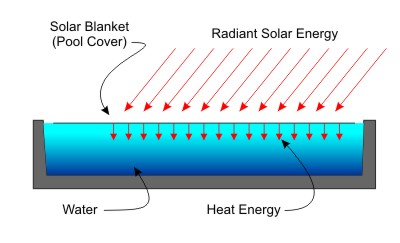
Figure Converting Radiant Solar Energy to Heat Energy
- Using the sun's radiant energy to heat water or other liquid, which is then used for secondary heating purposes, for example in heat radiators in a house. The heated water is in a closed system and uses radiation, conduction, and/or convection to transfer the heat to another application such as heating a room. In the simplified drawing below, a large storage tank of liquid is headed by solar radian energy. The liquid is then circulated through radiators in the house where the heat is transferred through radiation and conduction to the surrounding air.
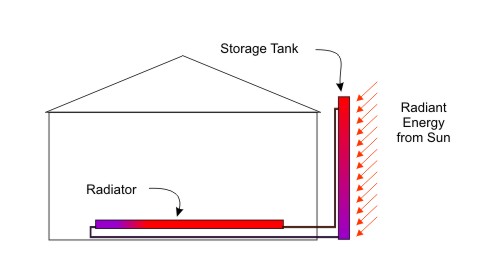
Figure Using Radiant Solar Energy to Heat a Building
- Using the sun's radiant energy to heat air directly. The heated air is blown directly into the building. A made-in-Newfoundland commercial system using this technology is available. It uses pipes made from 240 aluminium pop cans
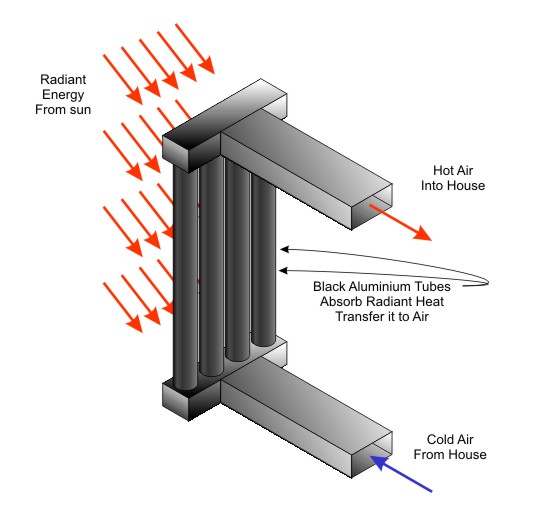
Figure Solar Radiant Energy used to Heat Room Air
- Using radiant energy to heat a large thermal mass. The collected heat is then given off over a longer period of time to heat a space such as a room or a greenhouse. The air is typically circulated with a fan. The thermal mass can be a pile of rocks, a black painted concrete wall or other material that can absorb energy and re-radiate it later when the surrounding air cools down.
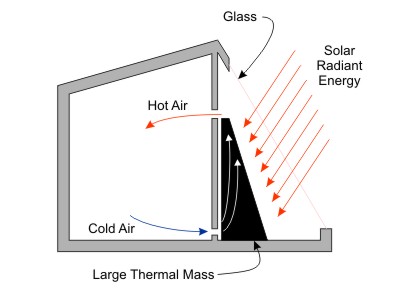
Figure Solar Radiant Energy Being stored in a Thermal Mass
Thermal Energy from the Earth
There are 2 primary techniques
- Extracting thermal energy from superheated water in geologically active regions in order to heat buildings and/or drive electrical generating plants
- Using heat pumps to transfer thermal energy from/to the earth in order to heat/cool a building
The high pressures in the earth's interior produce large quantities of (geo)thermal energy. In some locations this results in superhot gasses and steam very close to the surface. These can be used directly as thermal energy sources to heat buildings and drive turbines to produce electricity.
By using standard refrigeration techniques in a device called a heat pump, heat can be extracted directly from the ground in winter and transferred into a building. In summer the process can be reversed, transferring heat from the building into the ground. Heat pumps can also be used to extract heat from the air and transfer it to a building, and vice versa, but they are not as efficient as in ground units when the outside temperature is very low or very high
Motion Energy
Motion energy can be harvested in useful amounts from the following sources
- Wind
- Waves
- Tides
Wind Energy
Wind energy has been employed for centuries, primarily to convert the motion energy of the wind into mechanical energy to pump water (see also Energy to drive pumps) or to drive millwheels to grind grain.
Modern windmills are used to convert motion energy from wind into electrical energy. The wind turns the windmill's rotor (blades), which drives a generator. The generator converts rotary mechanical motion into electricity.
There are two basic types of windmill—horizontal axis and vertical axis.
Horizontal axis types are the familiar blades mounted on a horizontal shaft. As the blades get larger, the tower they are mounted on needs to be correspondingly taller and stronger. To get maximum efficiency (get the most electricity out of the system given its size and wind speed), windmills need
- To be high enough to get the rotor blades into the faster air above the ground surface
- To constantly point into the wind, even after wind direction changes.
- To change the pitch of the blade to accommodate different wind speeds, and to prevent rotation at very high wind speeds.
The principles of a horizontal axis windmill are illustrated in the next image (see also Electricity from turbines). The rotor turns slowly and the gearbox is used to rotate the generator at much higher rotations per minute.
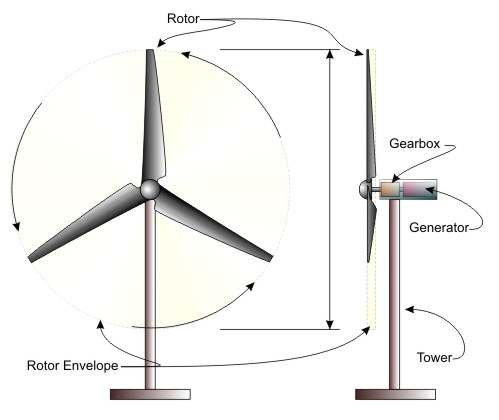
Figure Wind Energy Conversion to Electricity—Horizontal Axis Windmill
Vertical axis windmills use different approaches, but the common element is that the shaft on which the blade rotates is vertical. Vertical axis windmills always "point into the wind", but they do need to adjust for differing wind speeds and high winds. The also can be built more easily and much more cheaply.
The principles of vertical axis windmills are illustrated in the next image (see also Electricity from turbines). The design illustrated is known as a Darrieus design, after the French designer who patented it in 1931. The other major vertical axis design, from Sweden, is called the Savonius turbine.
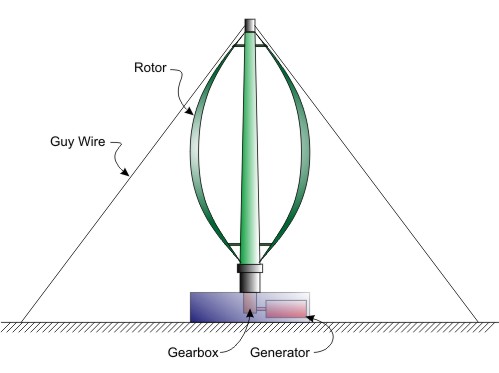
Figure Wind Energy Conversion to Electricity—Vertical Axis Windmill
Large numbers of windmills, called wind farms, are used to generate electricity for commercial electrical power. Wind generated electricity has a number of advantages
- It is pollution free, and does not use fossil fuels.
- It presents very little hazard for wildlife and birds.
- It is relatively quiet, although some complain about the rotor noise for large horizontal axis windmills.
- Windmills have a relatively small footprint on the land.
- Each megawatt (million watts) of wind generated electricity that replaces the equivalent in coal or diesel powered generators reduces greenhouse gas emissions by almost 1 tonne.
- Individuals, farmers, and communities can use wind generated electricity systems and sell power back to the grid.
Wind generated electricity has some disadvantages
- The amount of electricity generated depends on the wind. No wind means no electricity.
- For self-sufficiency, a method of storing electricity needs to be used. Typically this is a battery system. Adding electrical storage increases the cost significantly.
Wave Energy
Wave energy refers to the kinetic energy in waves as they travel through the water. Objects floating on the water rise and fall in a predictable elliptical pattern.
Harvesting wave energy for electrical power is a relatively recent process. A variety of designs have been developed. One, called the Limpet, is used for power generation on the island of Islay, off Scotland. Another, called the Pelamus, uses floating articulated cylinders to convert wave energy into electrical energy
Wave power has these advantages
- It is pollution free
- It is inexpensive to operate
- It can produce a lot of energy
It has these disadvantages
- Electricity production depends on wave action, so is unreliable
- It must be able to survive rough weather and massive hydraulic forces from heavy seas.
Tidal Energy
Tidal energy refers to the energy of the oceans. Two types of tidal motion are of interest
- The potential energy from the daily rise and fall of ocean levels in response to the influence of the moon and the sun on the oceans. The difference in height between low tide and high tide determines the available potential energy. Tidal power plants can generate large amounts of electricity (the one at Annapolis, Nova Scotia generates 20 MW, and the one at La Rance, France generates 240MW), but they can also cause difficulties for marine life.
- The kinetic energy from the tidal streams that sweep around the oceans, and in particular where they are concentrated in bays, or around large islands. The speed and volume of the tidal stream determines the available kinetic energy. Proposed tidal stream turbines designs ook similar to horizontal axis windmills. Information can also be found here, here, and here (Strait of Belle Isle project).
For More Information
For more information on the topics above, check these web sites
- The Energy Story - Chapter 15 Solar Energy
- Howstuffworks "How solar Cells Work"
- Scientific Forms of Energy Stored Energy, Kinetic Energy, Chemical Energy, Conservation of Energy
- Re-Energy.ca - Renewable Basics
- Energy 280-Megawatt Solar Boiler Uses Magnifying-Glass Bug-Killer Technique
- Heating and Cooling with a Heat Pump
- Howstuffworks How does a heat pump work
- Wind Energy
- waterpoweredsawmills (pdf file)
When you are ready, move to Your Turn